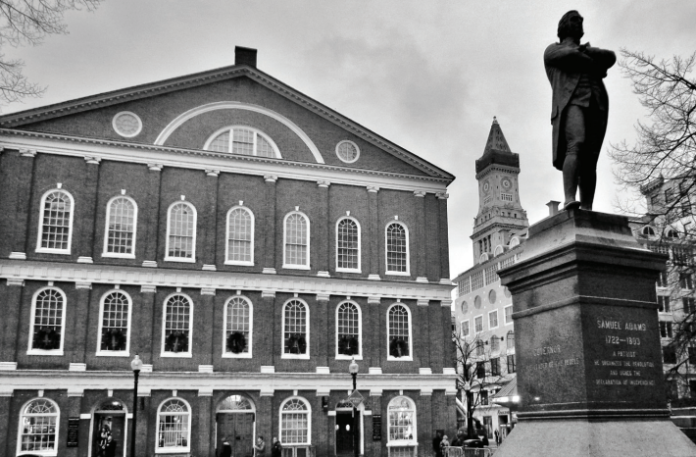Go deeper:
Committees of Correspondence: the Founders’ forgotten blueprint for political organization
Committees of Correspondence: a step-by-step guide for reviving the patriot network
Five things Thousand Oaks has in common with Revolutionary-era Boston
At times in a nation’s history, political power can fall into the hands of a ruling class, spurring everyday citizens with no prior political experience to ask themselves, “How can we guide our country back in the right direction?”
Our own Founders answered that question with a small but mighty, citizen-driven movement known as committees of correspondence. Don’t let the name fool you. These committees were fiery patriot rallies and organizational meetings for people fed up with the status quo. They soon led to a Revolution which has brought freedom to much of the world.
Committees of correspondence were the brainchild of Samuel Adams, sometimes called the Father of the American Revolution. At a November 1772 town meeting of patriots in Boston, Adams proposed that they elect a standing committee with two functions: to support pro-liberty activity in the city and to invite other Massachusetts towns to elect their own committees of correspondence. The Bostonians elected 21 members to their committee. They immediately selected a chairman, appointed a subcommittee to publish a proclamation detailing British violations of their rights (writing that it was “evident” that “Among the natural Rights of the Colonists are these: First, a Right to Life; secondly, to Liberty; thirdly, to Property”), and invited other towns to form their own committees of correspondence.
Within six months, 118 towns elected committees of correspondence and linked their activities back to Boston, thus establishing one of our earliest social networks. The committees did not need official legal authority to carry out their tasks, but still conducted business using formal parliamentary rules as a legislature would with quorums, motions and majority votes. When political activity occurred in any one town, the local committee of correspondence would send riders to the committees of other towns, disseminating news. Committees could publish proclamations or adopt ready-made ones created by other committees, keeping the entire colony quite literally on the same page.
The Founding generation thus responded to its increasingly despotic mother government using the same practical genius they later employed when constructing the new nation. According to the Boston Tea Party Museum, “It was very easy to establish and form a local Committee of Correspondence. Any localized group of Patriots could form a committee and join the vast network of Committees of Correspondence and serve as the Patriot voice for their respective region.”
Committees soon spread to other colonies, and their wide appeal and representative nature gave them moral authority, compensating for what they lacked in formal authority. The ingenious simplicity of Adams’ invention was its replication and scalability. In March 1773, Virginia’s patriots proposed that each colony establish a committee for inter-colonial communication and coordination. This evolved by September 1774 into a single continental committee. A majority of the delegates sent to the famous Continental Congress were men who first rose to prominence inside their local committees of correspondence.
Indeed, the system incubated the greatest political thinkers of the era and launched the careers of men like Thomas Jefferson, Patrick Henry, John Dickinson and John Jay. Committees are also linked to some of the most famous events in pre-Revolutionary America, including the Boston Tea Party, Paul Revere’s Midnight Ride, the Continental Congress and the subsequent boycott of British goods.
Committees of correspondence formalized patriotic leadership in a way that preserved accountability to the people without the corrupting influences of money, title and party. Patriotic leaders were developed and tested within a framework where they could interact and coordinate an effective response to abusive government policies. These fledgling public policy geniuses then established our American form of government in the U.S. Constitution.
What do these committees have to do with today? How can we preserve and defend the rights our forefathers fought to protect? Committees of correspondence offer a model that is repeatable, scalable, effective, free, peaceful and timeless. Patriotic boards of this kind can be revived in any city, at any time by simply calling a town meeting so the assembled patriots can elect leaders of various activist groups into a governing board. That board, committee or whatever it is called then invites neighboring towns to do the same and link together. The historical pattern counsels that county-level “committees” are established, followed by state-level committees before a continental one again unites an entire people in the common cause of liberty.
The committee structure removes barriers before potential leaders. Instead of having to raise lots of money and learn to work within a corrupted political system, they are elected to serve an immediate constituency in their own town or city. Their motives and principles are more likely to remain uncompromised. These committees can have enormous political power and influence as people recognize their moral authority.
The idea of committees of correspondence has remained dormant for nearly 250 years, waiting to be revived by a new generation of freedom-loving Americans. It worked for our nation’s founding — and it can work now.

